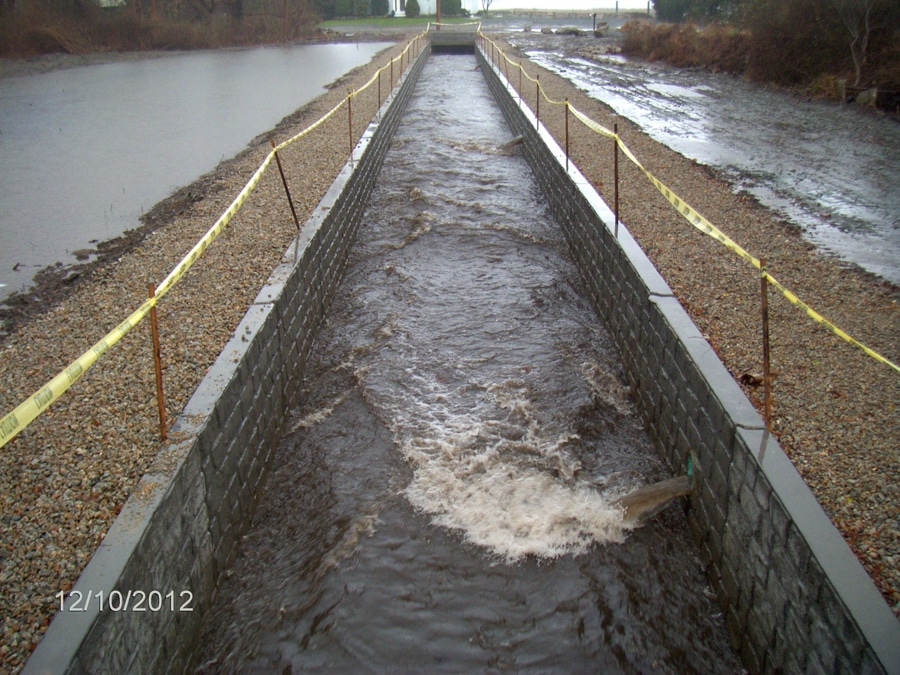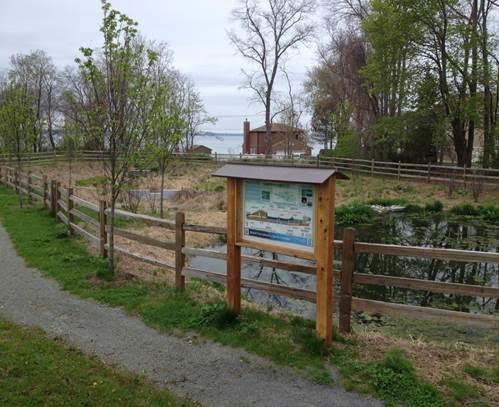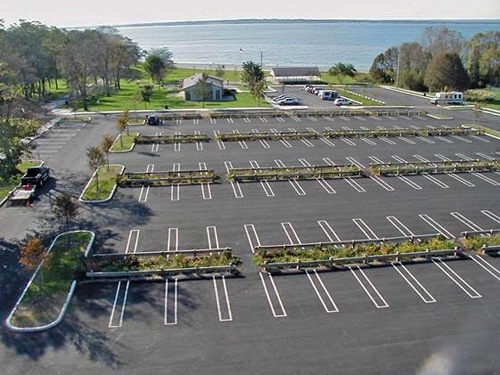Location: Bristol, Rhode Island
Highlighted Element: 452.d. Water Quality Regulations (WQ)
Point of Contact: Diane Williamson, AICP, CFM, Planning & Development Director, Bristol, RI
Bristol, Rhode Island is a small town located on an approximately 10.1-square-mile peninsula between Mount Hope Bay and Narragansett Bay. Home to approximately 23,000 year-long residents, Bristol is a historic coastal community that dates back to the late 1600s (U.S. Census Bureau, 2010; Town of Bristol, no date). The town was first settled by Europeans in the 1680s, and was named after Bristol, England (Town of Bristol, no date). Since its inception, residents have made their living off of the maritime industry, including manufacturing, boat building and tourism (Town of Bristol, no date). Today, Bristol is approaching build-out and struggles with nuisance flooding in neighborhoods due to under designed stormwater infrastructure and poor drainage. The town has also experienced several beach closures due to bacterial contamination where stormwater drains to the ocean.
Presently, many of the regulations that Bristol has in place to manage pollution to its waterways come down from the state. Bristol is a small Municipal Separate Storm Sewer System (MS4) community, meaning water discharging from its storm sewer system is regulated under a state permitting process called the Rhode Island Pollutant Discharge Elimination System (RIPDES) (Rhode Island Department of Environmental Management, no date). RIPDES is an authorized state program which has the authority to implement the US EPA's National Pollutant Discharge Elimination System. Common amongst all MS4 communities is that they must have regulations in place to manage pollution from construction activities, industrial sites and municipal stormwater systems (Rhode Island Department of Environmental Management, no date).
While all communities in Rhode Island are held to the same state standard, Bristol has taken a unique approach to implementing these regulations compared to other communities. In order to satisfy the MS4 permit requirements, the community has integrated the erosion control requirements during construction of new development, as well as the requirements for stormwater treatment post-construction into one, streamlined, permitting process (Town of Bristol Department of Community Development, no date). Specifically, before construction can even begin, the developer must submit plans for controlling soil loss from the site during construction, and propose Best Management Practices (BMPs) that will be permanently implemented to ensure that pre-development and post-development peak flows do not change. The developer must also ensure that average annual total suspended solids are reduced by 80% in post development runoff (Town of Bristol Code § Article 3 Section 29-57 - 27-80; BETA, 2008). These standards apply to all new development that is one or more acre (Town of Bristol Code § Article 3 Section 29-57 - 27-80).
Similarly, Bristol has integrated its regulations for stormwater management and erosion and sediment control. How did this integrated ordinance come to exist? The town had an old ordinance on the books focused specifically on stormwater. When Bristol became a regulated MS4 and subject to state regulations, local officials chose to integrate the new requirements into the existing ordinance, and expanded its scope to include soil erosion management and sediment control in addition to stormwater runoff. Having had stormwater regulations on the books at the time of this update meant homebuilders within the community were already cognizant and bought into the idea of needing to manage drainage and runoff from developments. Therefore they did not resist the additional requirements implemented within Bristol as a result of becoming an MS4 community. The town council and planning board were also accepting of the idea of having regulations for soil erosion, sediment control and stormwater management because they were aware of the flooding and water quality challenges faced by the town.
Did you know? Most communities already qualify for credit under this CRS element! Find out if your community qualifies for credit by checking out the profile for CRS Element 452.d. Water Quality Regulations.
With the implementation of these regulations alone, Bristol has already satisfied the CRS requirements in order to obtain full credit for Water Quality Regulations and some credit for Erosion and Sediment Control Regulations. But the town continues to go above and beyond what is creditable under the CRS to enhance the quality of the city's waterways, as well as to protect residents from flooding. For example, the Tanyard Brook is a channelized stream that flows through a densely populated part of town. When a child drowned in the stream in the early 1970s, the community elected to cover the stream with concrete slabs, effectively burying 90% of it. For decades the stream was out of sight and out of mind, but as the neighborhood became more populated and the density of development in the area increased, residents began experiencing more nuisance flooding. Eventually this area became a studied floodplain. The lot on which part of the steam was still above ground was bought by a developer who wished to subdivide the land and construct new housing. This heightened the awareness of the community to the issue of flooding, and they recognized additional development in the watershed could be problematic. As a result, the town conducted a study of the Tanyard Brook Watershed. The results of this study were used to inform the development of a special ordinance that applies to the Tanyard Brook watershed. The ordinance requires individuals within this watershed to control 100% of the runoff volume from their property on-site. Those who cannot control 100% of the runoff from their site are required to construct some off-site improvement or pay a fee that goes towards an off-site improvement. This provision was also rolled into the town's stormwater ordinance.

Bristol officials also conducted a study of another watershed within its town limits—the Silver Creek Watershed. This watershed faced several challenges, including a constraint at its outfall. Through this study the town sought to identify ways to restore the capacity of the watershed, and reduce flooding as a result. One of the methods identified was better prevention of soil erosion. Sedimentation in some areas was so severe there was virtually no difference between high and low tide because there was no place for the water to go. The outcomes of this report were used to do several improvements within the watershed (BETA, 2007).

Recently the town was recognized for its Town Beach project, which received two grants in order to retrofit their town beach. A pipe that handled stormwater from a large residential neighborhood to the north was identified as a point source for pollution discharge. They converted the pipe to a wet vegetated treatment system (Stormwater and Green Infrastructure Coalition, 2014). In addition, several pieces of green infrastructure, including planting more than 125 trees and building several bioswales, were completed (Stormwater and Green Infrastructure Coalition, 2014). On average this system of green infrastructure treats approximate 12 million gallons of stormwater each year. Prior to implementing these improvements, Town Beach experienced 72 beach closure days between 2000 and 2012. On average that is six beach closure days per year. Because of these efforts, beach closures diminished significantly, which resulted in an estimated $50,000 increase in revenue from the Town Beach over the course of five years (Stormwater and Green Infrastructure Coalition, 2014).

Best practices shared by this community:
- "We have soil erosion, sediment control, and runoff as kind of a big package because that is where we needed to be...My advice to other towns would be to just start with soil erosion... Everybody can see the muddy water running down the street when it rains. Everyone can see the dust on the street when they drive by...and hopefully developers can see the loam running off the street... Start with the simple soil erosion premise of keeping your soil on your site, and not having erosion through construction sites… And then you can build on that as you need to." -Diane Williamson
- "It seems daunting when you first take out the book… but when get right down to the individual credit points, for us it was something that we were already doing. And to be able to take credit and to get a potential discount for something that you're already doing it's not that hard. You just kind of have to go through it systematically, one by one, each section by section, and you'll get there." -Diane Williamson
Through these and other actions, Bristol has earned a CRS Class 8 rating, which results in a 10% discount in flood insurance. This is associated with a $78,000 annual discount for flood insurance policyholders.